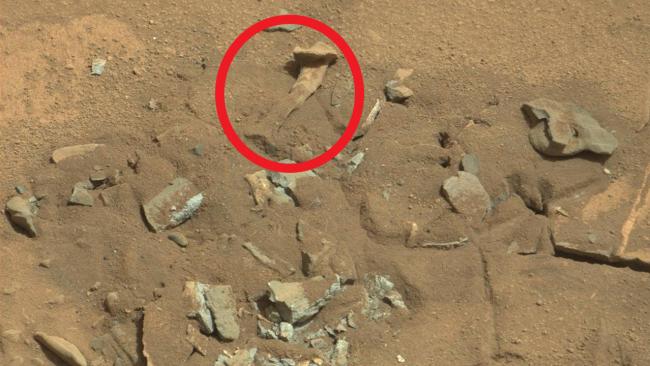| Online: | |
| Visits: | |
| Stories: |
NASA Says A Thigh Bone Was Not Found on Mars
 |
| That’s a rock, NASA says. (NASA/JPL-Caltech/MSSS) |
An image from the Curiosity rover that some people thought showed a “thigh bone” on Mars is just a photo of a weathered rock, according to NASA. The photo shows the dirt-covered surface of Mars littered with bits of rock, one of which is elongated in a shape similar to a leg bone…
The image was first picked up on a UFO blog, Space.com reports, purporting to show evidence of past alien life on the planet. The claim got so much attention that NASA released the photo with an official explanation — saying the object did look like a thigh bone, but it most definitely is not.
“No bones about it! Seen by Mars rover Curiosity using its MastCam, this Mars rock may look like a femur thigh bone,” the site reads. “Mission science team members think its shape is likely sculpted by erosion, either wind or water.”
Though the Curiosity rover has found evidence that Mars could have supported life in the past, the planet likely never had enough oxygen for that life to grow any bigger than microbes, according to NASA. So a fossil of a large, complex organism is “not likely.”
This is not the first time NASA has quelled speculation about seemingly odd finds on Mars. All of the rovers’ raw images are available for free online, and enthusiasts combing through the pictures often find objects that spark conjecture about alien remnants or activities.
In February, for instance, a rock that suddenly appeared in what before had been empty ground near the Opportunity rover caused some to think aliens had moved it there. NASA stated that Opportunity’s wheels kicked up the rock as it moved.
And in April, some said a strange light in the distance in one of Curiosity’s images looked like it came from artificial sources. But images of the same spot at the same time from multiple sources revealed the oddity to simply be a trick of the light, and is likely sunlight glinting off a rock.
Seeing faces, animals or other shapes that aren’t actually there is called pareidolia, Space.com reports. On Mars, when in doubt, it’s a rock.
Source: http://www.ascensionearth2012.org/2014/08/nasa-says-thigh-bone-was-not-found-on.html




